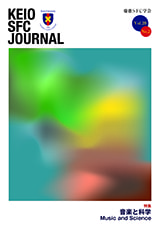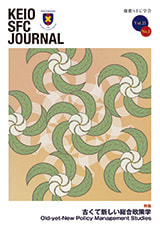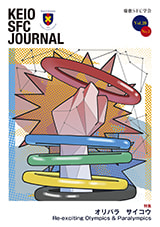- HOME
- KEIO SFC JOURNAL
- Vol.20 No.2

Music and Science
-
Foreword
Download this article (PDF): SFCJ20-2-00.pdfShinya Fujii (Associate Professor, Faculty of Environment and Information Studies, Keio University)
-
Music Science with COVID-19
Download this article (PDF): SFCJ20-2-01.pdfJun Murai (Distinguished Professor, Keio University) Daito Manabe (Guest Professor, Faculty of Environment and Information Studies, Keio University) MC: Shinya Fujii (Associate Professor, Faculty of Environment and Information Studies, Keio University)
-
Science of Song
Download this article (PDF): SFCJ20-2-02.pdfYouichi Kitayama (Professor, Faculty of Environment and Information Studies, Keio University) Patrick E. Savage (Associate Professor, Faculty of Environment and Information Studies, Keio University) Shinya Fujii (Associate Professor, Faculty of Environment and Information Studies, Keio University)
-
[Research articles]
Musical Diversity in India ―A Preliminary Computational Study Using Cantometrics
Hideo Daikoku (Master’s Program, Graduate School of Media and Governance, Keio University) Anna L. C. Wood (President, Association for Cultural Equity, New York City, USA) Patrick E. Savage (Associate Professor, Faculty of Environment and Information Studies, Keio University) The degree of musical diversity within and between societies is a topic of long-standing debate with theoretical implications for cross-cultural musical comparison. Standardized cross-cultural data on musical variation from Alan Lomax’s Cantometrics Project newly made available via the Global Jukebox allows us to attempt to quantify this variation. Here we perform a case study of traditional Indian vocal music using the 37 Cantometric features for 207 traditional songs from 32 Indian societies. Principal Component Analysis identifies complexity of vocal style as the primary factor shaping musical variation in India, consistent with Lomax’s previous analyses of global variation. We find only very minor musical differences on average between speakers of different language families (Indo-European, Dravidian, and Austro-Asiatic), but greater variation between societies within language families. Additionally, we demonstrate how quantitative analysis can be strengthened by observations from musicians with direct experience of local traditions and applied to local/regional musicological questions.
Download this article (PDF): SFCJ20-2-03.pdf -
[Academic trend reports]
Musical Dynaformics ―Motor Neuroscience for Musicians
Shinichi Furuya (Researcher and Program Manager, Sony Computer Science Laboratories Inc./Guest Professor, Hannover University of Music, Drama, and Media/Research Associate Professor, Sophia University/Guest Professor, Kwansei Gakuin University) Neurosciences and music, often called “Neuromusic”, is an interdisciplinary field consisting of neuroscience, psychology, cognitive science, neurology, and biomechanics. The field has been growing up during the past three decades in the world. In contrast, little has been recognized about this field among researchers in Asian countries. This article introduces a history and targets of the Neuromusic researches, and also argues potentials of researches on music performance (i.e. Musical Dynaformics).
Download this article (PDF): SFCJ20-2-04.pdf -
[Review articles]
Relationship Between Musical Function and Mental Disorders ―Potential and Progress of Neurosciences and Music in Psychiatry
Shiori Honda (Doctoral Program, Medical Science Specialty, Graduate School of Medicine, Keio University) Yoshihiro Noda (Project Assistant Professor, Department of Neuropsychiatry, School of Medicine, Keio University) Shinichiro Nakajima (Research Associate, Department of Neuropsychiatry, School of Medicine, Keio University) Shinya Fujii (Associate Professor, Faculty of Environment and Information Studies, Keio University) How human musical function in the brain (perception and production of melody, rhythm, and harmony) is affected by mental disorders? In this paper, we review the previous studies on musical function in people with mental disorders such as savant syndrome, frontotemporal dementia, major depressive disorder, and schizophrenia. We discuss the limitations of the previous studies for further understanding of neurological mechanisms underlying the facilitation and deterioration of musical function in people after mental disorders. We propose the importance of neuromusic (neurosciences and music) research for progress of evidence-based neurological music therapy for mental disorders.
Download this article (PDF): SFCJ20-2-05.pdf -
[Review articles]
The Future of Acoustic Design: From the Perspective of “Kansei” Science
Rento Tanase (Cloud Business Department Audio Products Business Unit, Yamaha Corporation) Behavior modification to “New Normal” for global measures of COVID 19 affects the environment of sound and music. Interconnection of physical spaces on the Internet is redefined as “online environment” and its influence on recognizing and learning processes for sound is discussed. Sound and acoustic design method with collective intelligence extracted from nonverbal “Kansei” information is proposed. Here, cloud technologies and the scientific Kansei technique are combined. In addition, the concept of IoH (Internet of Human) is mentioned as integrated intelligence of humanities, social science, and natural science. Industry-government-academia collaboration is expected for rapid construction of new sound design.
Download this article (PDF): SFCJ20-2-06.pdf -
[Practice reports]
Urban Composition ―Creating Music and Sound Arts from Urban Phenomenon
Kenta Tanaka (Project Researcher, Graduate School of Media and Governance, Keio University) Shinya Fujii (Associate Professor, Faculty of Environment and Information Studies, Keio University) In this paper, we explore the possibilities of Urban Composition - composition of music and sound art from urban phenomenon - to create fruitful interactions between music and the city. We review previous sound arts and urban studies after the 20th century including the works by Luigi Russolo, John Cage, Murray Schafer, Max Neuhaus, Bill Fontana and others in order to examine how sound artists have been inspired by urban phenomenon. We also introduce the examples of Urban Composition by the authors to consider the relationship between music and the urban phenomenon. We speculate that interaction between physical and cyber spaces is the key to create the future of Urban Composition and the next, experimental, expressive, “x-Music” that has yet to be named.
Download this article (PDF): SFCJ20-2-07.pdf -
[Research articles]
Creface ―A Conceptual Model for Improvisational Creativity
Yuta Uozumi (Project Assistant Professor, Graduate School of Media and Governance, Keio University) Technologies such as AI and robotics are blurring the boundaries between machines and humans. Consequently, considerations about the "creativity" of humans and/or nature have become more important in both fields of art and science. Results of research such as multi-agent, embodied cognitive science and swarm robotics indicate that creative behavior is inseparable from interaction with the environment. Therefore, this paper proposes a conceptual model for designing improvisational creativity including environment and body. Improvisational creativity is the behavior that creates something without a centralized controller and reworks, as in musical improvisation. This is an extreme circumstance of creativity. Hence, the composition of a system with this type of creativity brings about an understanding of the principle of music.
Download this article (PDF): SFCJ20-2-08.pdf -
[Research articles]
Can AI Be Creative? ―A Proposal of an Extended Framework of Generative Adversarial Networks
Nao Tokui (Associate Professor, Graduate School of Media and Governance, Keio University) As the social implementation of Artificial Intelligence (AI) advances, the use of AI in the creative domains of art and design is being explored. In particular, many studies and examples of works have already shown that AI can generate “realistic” images and music as if they were created by humans by using Generative Adversarial Networks (GAN) and other generative models. On the other hand, one can argue that what generative models do is simply a reproduction of statistical patterns learned from training data and question their novelty and originality as expressions. In this paper, we examine the current state of AI and creativity and propose a method for creating novel expressions, especially musical expressions, by extending the GAN framework. Through these, we consider the future in which AI will contribute to creating expressions that are not mere imitations of human creations.
Download this article (PDF): SFCJ20-2-09.pdf -
[Progress reports]
A Perspective on Art and Science
Akira Wakita (Professor, Faculty of Environment and Information Studies, Keio University) Since 2015, the author has been working across art and science. Many of the works have been invited to several exhibitions, mainly in Europe, and the author has been in dialogue with the artists, scientists, and curators involved. In this research note, empirical interpretations from those activities and analytical interpretations from a later literature review are presented.
Download this article (PDF): SFCJ20-2-010.pdf
-
[Research articles]
An Exploratory Study of the Process of University Students’ Consciousness Formation ―The Practice of Life Story Interviews
Azusa Shomura (Doctoral Program, Graduate School of Media and Governance, Keio University) The purpose of this study was to explore the process of students’ consciousness formation in life story interviews with employees in career education at their university. Application of the modified grounded theory approach (M-GTA) generated six categories and 29 concepts from 19 students. In the class, it was demonstrated that students likely experienced the process of construction-deconstruction-reconstruction twice through self-reflection and self-exploration in relationship with others. Four distinctive processes were identified through individual insights. The results suggest that this program could facilitate students’ development of career self-reliance and career self-efficacy.
Download this article (PDF): SFCJ20-2-011.pdf -
[Research articles]
Lithuanian Civil Defense Sector and Its Context in the 2010s ―A Case of Critical Thinking on the Narrative
Kentaro Okawara (Doctoral Program, Graduate School of Media and Governance, Keio University) This paper examines the narratives in Lithuanian civil defense policies. According to some discussions, the Lithuanian civil defense is seen as a type of “all-out war,” and is influenced by a Swiss-style “levee en masse” regime. Lithuania’s tragic history of partisan battles against the ex-Soviet Union is referred to in these discussions. However, the author concludes that Lithuanian civil defense equates to simply protecting themselves from invasion rather than “battling”, which means the more heroic (and commonplace) narratives. Lithuanian defense power is not enough to execute “all-out war”.
Download this article (PDF): SFCJ20-2-012.pdf -
[Research articles]
Effectiveness of International Investment Agreements
Akiko Saito (Doctoral Program, Graduate School of Media and Governance, Keio University) Osamu Kurita (Professor, Faculty of Science and Technology, Department of Administration Engineering, Keio University) This research addressed a question on which country/countries are likely to have developed “effective” positioning by concluding international investment agreements (IIAs), by using data for 100 countries based on the large number of IIAs that each country has concluded. The effectiveness, or the “advantage of position” of IIAs in this research, is examined by the calculation of eigenvector centrality. Our conclusions included that China has the most effective positioning in having IIAs among the selected 100 countries in this research.
Download this article (PDF): SFCJ20-2-013.pdf -
[Research articles]
Language Learning and Identity Formation In-between Cultures Among Youth from Military Families ―A Case Study from a Military Educational Institution in Japan
Toshino Koike (Master’s Program, Graduate School of Media and Governance, Keio University) The study observed English as a Second Language (ESL) teens in a military institution in Japan. The focus is on identity formation of these teens, such as being in-between, referring to the extent the students feel as being part of several different cultures and communities. This will be examined by looking at the link between family relationships, pathways, emotions, and language learning. The research method used was a long-term participant observation and in depth interviews to contextualize and understand the participants’ view on their identity formation. The study found that family members have the most impact on the identity formation among these youths.
Download this article (PDF): SFCJ20-2-014.pdf

